UA Biologist Seeks Pharmaceuticals from Undersea Laboratory
By Chris Bryant
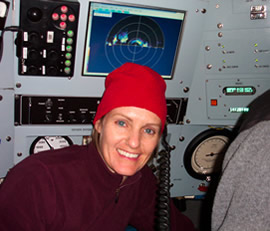
The world has a drug problem. It’s not limited to the one you may be thinking of, and scientists are starting to look for solutions to it in places you might not imagine – places like the surfaces of volcanoes lying almost a mile beneath the ocean’s surface.
Yes, substance abuse inflicts a near incalculable toll on the human race. And, it’s true the rising costs of pharmaceuticals are adding to the growing health care crisis society faces. But it’s another less publicized, but very real, drug-related quandary, that Dr. Julie Olson, assistant professor of biological sciences at The University of Alabama, says scares her.
Based on the bevy of television commercials promoting the benefits of new pharmaceutical drugs, you might think they are developed every minute, but these drugs aren’t new to the extent you might think, the UA biologist says.
“Really, what we’re seeing is a lot of the same general structures,” Olson says. “We’re not seeing new classes, new families of compounds, and that is scaring us desperately because we are starting to lose the battle.”
Those battles are against such foes as bacterial and viral infections that have the ability to mutate ever so slightly, yet enough to render current treatments ineffective. Improper use of antibiotics, including over prescribing and failure to complete treatment cycles, can exacerbate the problem.
“We’ve made it so a lot of our drugs are losing their effectiveness faster than they should be,” Olson says. “And there’s not a lot on the horizon to come and take their place. We need new classes – things that organisms have not seen in a hospital setting – to keep us going the next 50 to 100 years. Right now, there’s not a lot in the pipeline.”
With the help of two submarines, a string of underwater volcanoes northeast of New Zealand, and the organisms that live there, including some of which have never been previously identified, Olson, 11 of her colleagues, and a UA graduate student, hope to find some new leads with pipeline potential.
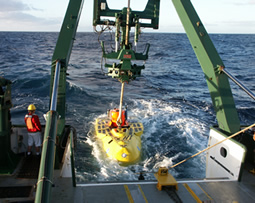
Using the submarines and a mother ship, Olson and the international research team recently completed six dives, some nearly one mile deep, where they collected about 20 macroorganisms (such as sponges, sea fans, barnacles and mussels) and isolated about 250 microorganisms (such as bacteria and fungi) to assess their biomedical potential.
Such potential often comes from the form of defense mechanism the organism uses in seeking a competitive advantage against its cohabitants, Olson said.
“If you can’t physically move, you have to have some way to defend yourself,” the UA biologist said. “Usually, that’s in the form of chemicals. If you look at some of the pharmaceuticals that we have currently, they come from bacteria, fungi and plants – things that really don’t move terribly quickly.”
Rather than escape, these organisms often survive by using these chemicals to kill off their competition for resources.
“That’s what we’re trying to harness – the capability of these organisms to fight off their competition – and use them for human drugs. Most of our antibiotics – anti…against…bio…life – have come from organisms that are fighting off other life forms in order to gain a competitive advantage in their environment.”
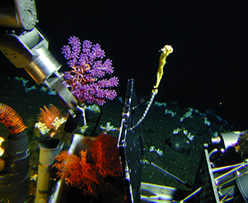
Creatures living underneath a mile of sea water and in close proximity to underwater volcanoes, some of which are active, have to be uniquely adapted to survive in their environment. It’s an extreme environment, one where temperatures can exceed 250 degrees Celsius and pressure is more than 150 times that on the surface.
“We’ve had a fair amount of success looking at non-extreme organisms, so now we’re trying to take it one step further,” Olson says.
That next step involves the researchers studying, not the enzymes the organisms produce, as is the more typical approach, but the secondary metabolites they produce. Unlike primary metabolites, secondary metabolites are not essential to life, but these chemical compounds are sometimes produced by organisms, as a protective measure, when they start to become nutrient limited, Olson explained.
Using the submarines, equipped with manipulator arms, suction pumps, scoops, high resolution underwater DVD recorders and a mixture of unique sampling devices, samples were retrieved from the various underwater volcano sites.
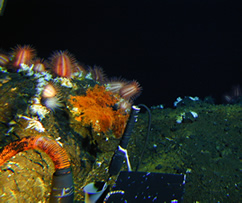
These samples were brought back to Olson’s UA laboratory where some of the collected bacteria are isolated, grown in culture and evaluated. Olson and a graduate student, Tyler Hodges, who also provided assistance during the deep sea dives, are looking for microorganisms that produce secondary metabolites.
Hodges said the dives, each lasting about eight hours, were “amazing,” if a bit cramped, and make the subsequent lab work more meaningful.
“The sub feels like being in a space capsule,” Hodges said. “It’s three people lying on our sides, or stomachs, in this crammed little space, but it’s definitely worth it. The geological formations and abundance of life were extraordinary.”
Promising lab results are sent to the National Center for Natural Products Research at the University of Mississippi, for further analysis.
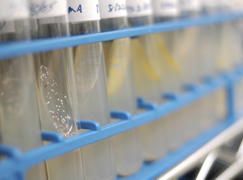 Olson’s work in the project is sponsored by the National Oceanic and Atmospheric Administration’s National Institute for Undersea Science and Technology, known as NIUST. Other sponsors of the 8-day research cruise were NIUST’s Ocean Biotechnology Center and Repository, NOAA’s Hawaii Undersea Research Lab and New Zealand’s Geophysical & Nuclear Sciences Institute.
Olson’s work in the project is sponsored by the National Oceanic and Atmospheric Administration’s National Institute for Undersea Science and Technology, known as NIUST. Other sponsors of the 8-day research cruise were NIUST’s Ocean Biotechnology Center and Repository, NOAA’s Hawaii Undersea Research Lab and New Zealand’s Geophysical & Nuclear Sciences Institute.
Co-chief scientists for the research expedition were Dr. Marc Slattery, director of the Ocean Biotechnology Center and Repository at the University of Mississippi, and Dr. Alex Malahoff, director of the Hawaii Undersea Research Lab.
“We are trying to come up with some anti-virals that would be effective against some of these nasty diseases that have the capability to keep changing, which is part of the reason we have so little success, relatively speaking, with HIV,” Olson said. “We cannot vaccinate, as of yet, effectively against HIV.”
Olson said the odds of finding a potential disease-fighting lead near New Zealand’s Kermadec Arc, are daunting. However, with an approximate 15-year turnaround from the time a potential new drug is discovered until FDA-approval for commercialization is granted, scientists try to leave as few unturned stones as possible in their search.
“It’s like looking for a needle in a haystack, but someone has to go looking for it.”
Further Reading